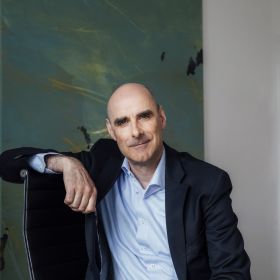Identifying the traits that really promise great leadership
Even organizations with long histories of nurturing outstanding talent have begun to question their ability to correctly identify potential leaders. Why? Because the rapidly evolving business world has exposed the inadequacies of existing models for assessing potential. Past performance and current capabilities offer no guarantee that an individual will succeed in dramatically different work roles and environments of high-velocity change. Now, however, a new model of potential, encompassing the four deep personal traits that foretell great leadership, is providing the accuracy, rigor, and discipline that you need to uncover the real promise in people and manage it for competitive advantage.
Spectacular misjudgments of potential are the stuff of legend: A Munich schoolmaster predicted in 1895 that Albert Einstein “would never amount to anything.” The news editor of a Kansas newspaper fired the young cartoonist Walt Disney because he “lacked imagination.” When Indira Gandhi first became India’s Prime Minister a rival politician sized her up as no more than a “gungi gudiya” – a “mute doll.”
It’s a phenomenon every business person is familiar with. Six years ago, for example, a major company wanted to terminate a mid-level executive whom they believed to have little future in their business. But a talent assessment determined that she possessed more potential than any of the executives at her level, as did a subsequent assessment three years later. Today, she is CEO of the company.
Often, of course, misjudgments go the other way – a new CEO, anointed company savior by the Board, turns out to be in far over his head; a young executive deemed a high potential flames out in her first stretch assignment; a promising mid-career executive makes a long leap to the C-suite and lasts less than a year. In fact, in recent years, we’ve seen clients, many of whom have long track records of developing outstanding talent, begin to question their ability to correctlyidentify potential leaders, especially at the SVP and C-level. And we continue to see many instances of executives whose potential isn’t being fully realized in their current roles.
Why do so many get potential so wrong so often?
Most models and organizations get potential wrong because they confuse it with an individual’s performance or current capabilities. An executive’s career trajectory – the shape it takes over a professional lifetime – consists of three key elements: past performance, current capabilities, and potential for the future. All three elements are important in a comprehensive assessment of an executive, but they should be kept distinct. Potential is not about what individuals have done or their current readiness for a promotion. It is about capacity and speed: to what extent and how fast they could develop senior executive competencies commensurate with leadership roles that are greater in both size and complexity.
The systematic confusion of potential with other elements of career trajectory may result in an approach to managing potential that:
- Relies heavily on how someone has performed at a point in time
- Fails to fully leverage an executive’s potential in a current role
- Confuses ability in the current role with ability to take on a new, more complex, and possibly quite different role
- Focuses on the short-term – the next job – instead of on the individual’s long-term capacity for demonstrating senior leadership competencies
- Fails to enable the early identification of potential
- Misses opportunities to identify “diamonds in the rough” and accelerate their growth
- Operates without a clear definition of potential and clear criteria for identifying it
我的理解是不能准确评估的潜力t be managed, leaving the organization to face recurring and seemingly inexplicable underperformance by some individuals, the departure of unrecognized talent, and a progressive weakening of the organization’s ability to compete successfully. The cost in human terms is also high – experience shows that a dismayingly large percentage of executives get derailed at some point in their careers, often needlessly.
A less forgiving future
The costs, both economic and human, will get even higher, as past performance and current readiness become increasingly less predictive of future performance by individuals or companies. Markets, competitive environments, and business models are changing in ever shorter cycles. For example, emerging markets, many of which most companies understood little if at all, loom larger than ever in plans for corporate growth. Meanwhile, competitive environments today require executives to understand a wide range of new disciplines including sustainability, digital, social media, big data, and global diversity. About business models, senior editor of Fortune magazine Geoff Colvin writes, “Your business model doesn’t work anymore. That blunt claim won’t be far wrong. Even if the model has worked for decades, even if it’s working okay right now, odds are that it soon won’t be.”
在这个即将到来的未来,公司将have to rely more heavily than ever on getting potential right. They will need leaders who are able to take on unforeseen work roles, adapt to new organizational structures, and work in environments of head-spinning change. And they will need more of those leaders than ever. As Gary Hamel, who was recently ranked by the Wall Street Journal as the world’s most influential business thinker, told a McKinsey & Company interviewer: “I think the dilemma is that as complex as our organizations have grown, as fast as the environment is changing, there are just not enough extraordinary leaders to go around.” To build truly more adaptable organizations, he says, we must “syndicate the work of leadership more broadly” in the organization. Enlarging the circle of leadership in that fashion will require companies to identify potential leaders earlier, develop them faster, and empower them sooner – or risk a fatal inability to adapt to business disruptions that the future will deliver with increasing regularity.
Toward a new understanding of potential
To develop a valid, distinct, and practicable model of potential, an Egon Zehnder team drew on our extensive experience in management appraisal – including more than 500 appraisals of CEOs around the world. We also analyzed the career trajectories of more than 1,000 C-level executives and 2,500 non-C-level executives that our firm has appraised, and validated our model with CEOs, board members of major companies, and leading academics.
The framework we created consists of four traits, which when properly assessed predict development of executive ability and the speed of that development:
- Curiosity:Individuals with a high degree of curiosity proactively seek new experiences, ideas, and knowledge. They solicit feedback and are open to learning and change. It’s not merely idle curiosity: They are energized by constantly refreshing themselves on an intellectual, experiential, and personal level.
- Insight:People who exhibit great insight will be able to gather and make sense of a vast range of information, transform past views (including their own), and set new directions. They will switch effortlessly between the conceptual level and the intelligent analysis of granular data. That means that they are likely not only to discover new insights but to apply them in highly productive ways.
- Engagement:Those who score well on engagement will know how to connect on an emotional and logical level with others, not just one-on-one. They will be able to communicate a persuasive vision and help others feel more connected to their organization and leader.
They will pursue self-awareness, demonstrate empathy, and be able to inspire commitment. - Determination:This trait encompasses a combination of attributes: the courage and willingness to take intelligent risks, persistence in the face of difficulties, and the ability to bounce back from major setbacks or adversity. Deeply determined individuals will also continue to look for disconfirming evidence, and they will be willing to change direction when necessary.
Traits predict what kinds of behaviors individuals are likely to demonstrate in the future – that is, the competencies people will manifest in particular roles in particular organizations and cultures. The degree to which someone possesses those traits also predicts the magnitude of the competencies that will develop. Someone can of course have the traits and not yet have demonstrated the competencies. But having the traits creates a high probability of demonstrating the competencies at the highest levels of leadership.
最有趣的是,我们发现这四种traits, curiosity is the major differentiator of potential. That German schoolboy who wasn’t supposed to amount to anything credited his success to his curiosity. The degree of curiosity determines the speed with which an individual will exhibit the behavior associated with the other three traits and predicts the variance in job performance that will result. Curiosity is also the trait that is most likely to be missing or undervalued in most models of potential, which could account for the failure of so many models to gauge potential accurately.
As unforeseeable and profound changes in the business environment increasingly thrust leaders into roles with steep learning curves, the underweighting of curiosity will have progressively more serious consequences. Other researchers, notably Patrick Mussel, have independently reached similar conclusions. In “Introducing the construct curiosity for predicting job performance,” he writes in The Journal of Organizational Behavior: “Curiosity is an important variable for the prediction and explanation of work-related behavior. Furthermore, given the dramatic changes in the world of work, the importance is likely to rise, rather than to decline, which has important implications for organizational theories and applied purposes, such as personnel selection.”
Putting potential to work
With a clear and distinct definition of potential, a model with real predictive power, and a proven method for measuring its elements, you can bring new rigor and discipline to a wide range of critical talent management activities:
Objectively assess potential.By assessing potential in terms of traits – in effect, how the person naturally behaves – organizations can look past the unconscious biases that prevent almost everyone from accurately interpreting the behavior, character, and motives of people who differ from them.
Understand the potential of your people early on.Harnessing your potential early allows you to develop it fully. Additionally, although traits can be developed or improved, it takes time, effort, and a customized plan to move up the scale even a modest amount, so the earlier the assessment the better. Early measurement of potential is possible because deep-seated traits can be evidenced at an early age. In 1922, Yuzo Sakakibara, the owner of a Tokyo automobile repair shop, took on a 15-year-old apprentice who had been inspired by his love for automobiles to seek the position. Sakakibara saw in the boy a hard worker with an extraordinary ability to readily absorb and apply technical expertise, despite having only an elementary school education. So Sakakibara took him under his wing and nurtured his talent. That boy was Soichiro Honda, who went on to create the global company that bears his name.
Reduce organizational risk in succession, promotions, and hiring.By ensuring that potential is an integral part of talent assessments throughout the organization – in external hires, in internal promotions, in succession planning at all levels – you can avoid mistakes that can result in everything from inconsistent performance to company failure. The bigger the role to be filled, the greater the risk to the organization – starting with the CEO. In the U.S. and UK, approximately 70 percent of recently appointed CEOs are first-time chief executives. Given what is at stake in the choice of CEO, boards need a reliable way to predict future success in a role in which a possible successor has no prior experience.
Plot appropriate career paths.Clients often ask us if an individual has potential, but they seldom ask potential for what? By developing people in light of their traits that predict success in leadership roles, you can make sure that they reach their true potential, fully leveraging their natural strengths and effectively compensating for their natural weaknesses. You can also have a clear idea of the kinds of roles in which they are likely to thrive, avoiding the mismatches of individuals and roles that result in lower productivity, poor morale, and ineffectiveness for the individual and the organization.
Address the root causes of performance problems.如果一个领导能力上表现欠佳equired for a role – or the role changes in unforeseen ways, requiring a competency that the leader lacks – you can find the root cause of the problem by tracing it back to a related trait in which the leader might be deficient. For example, a B2B company whose products are in danger of being commoditized decides to pursue a higher-margin strategy of bundling products with consulting services and building long-term customer relationships. But the sales force, led by the long-time head of sales, continues to make high-volume/low-margin sales of discrete products and fails to build customer relationships. A look at the assessment of the sales head’s potential reveals that among the four leadership traits, engagement is his weakest. As a result, he has failed to persuasively communicate the company’s new vision to his people. Having traced the problem to this root cause, you can then intervene – through coaching, a new role, or some other appropriate remedy, depending on the depth of the deficiency.
Make the most of high-potential programs.Early and accurate identification of genuinely high-potential executives enables the organization to invest in promising people from the start, accelerate their development, and reap the benefits in the upper echelons of management faster.
Maximize return on human capital.Whether you are helping people reach their full potential in their current roles, tap into their inner resources as new challenges arise, or prepare for bigger roles, a sound understanding of potential can save resources misplaced on development activities that don’t net results and help yield the greatest return from activities that do.
Customize retention.When it comes to retention, one size does not fit all. By developing and rewarding people in sync with their capacity to take on leadership roles that are greater in both size and complexity, and the speed with which they can do so, you increase the likelihood that they will find their work fulfilling and remain with the organization. In Japan, “tenure-based equal promotion systems” are now giving way to development linked to potential. With the idea of lifetime employment at a single employer diminishing,promising executivesat traditional companies are less reluctant to leave, and many of those companies now realize that keeping people in a role they have outgrown drives them away. Conversely, by taking potential into account you can also make sure that you don’t overload people – giving them assignments that stretch them to breaking point.
Ultimately, potential is not simply about the capacity of individuals but about the potential of organizations. Like people, companies have strengths and weaknesses – areas in which they excel and areas where they lag. By accurately assessing potential throughout the organization, you can create comprehensive talent strategies to correct organizational weaknesses, better leverage strengths, create pockets of innovation, and change direction to seize opportunities.
Most importantly, you can be assured that you have a deep bench of talent with the requisite curiosity, insight, engagement, and determination to meet head-on the infinitely complex commercial world that is now emerging, with its unforeseeable roles and demands. Talent will remain the great differentiator in that coming world, and the organizations that thrive there will do so because they got potential right, right now.
THE AUTHORS
Karena Strellajoined Egon Zehnder in 2001. She is based in San Francisco and is responsible for the Firm’s assessment methodologies and tools and is a member of the Excutive Assessment & Development, Human Resources, and Life Sciences and Healthcare Services Practices.
James Martinis a consultant with Egon Zehnder in London. He joined the Firm in 2000 and is a member of the Excutive Assessment & Development, Services, and Human Resources Practices.









